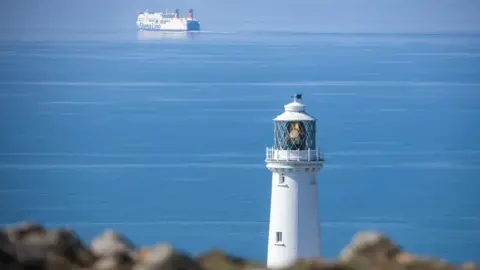Power project could be 'devastating' for island seabirds
 Richie Roberts
Richie RobertsPlans for a massive tidal energy project off the Welsh coast could have a devastating impact on seabird populations, RSPB Cymru has warned.
The charity says it has "grave concerns" about a planning application for the Morlais scheme off Anglesey.
It claims an assessment by the scheme's backers shows 60% of guillemots and 97% of razorbills could be lost from cliffs at South Stack, near Holyhead.
But developers Menter Môn said that was a "worse case scenario" only.
The not-for-profit social enterprise said there was no evidence worldwide suggesting wildlife would be damaged by such tidal flow energy schemes.
The Morlais project would see a development on 35 sq km (13 sq miles) of seabed, generating up to 240MW of electricity from the power of the tides in the Irish Sea.
It would make it one of the largest tidal stream energy sites in the world.
 Getty Images
Getty ImagesBut the RSPB said it feared "political and economic pressures to complete the application are pushing this development to take unmanageable risks with our fragile marine environment".
"If this project is serious about being a test bed for new marine energy generation technologies in an environmentally sensitive way, it must proceed in a step-wise manner, learning from each stage," insisted RSPB Cymru director Katie-jo Luxton.
"However, our faith in this approach is jeopardised by Menter Môn seeking blanket, large scale consents.
"We are calling for the large 240MW scale proposal to be withdrawn and be replaced by a smaller scale initial 'pilot' project."
The charity has a large presence in the area, with its South Stack nature reserve attracting about 250,000 visitors a year.
Between March and July, the sea cliffs are home to the nesting populations of razorbills, which spend most of their life at sea.
The reserve is also a prime location to spot puffins in the wild.
Menter Môn told BBC Wales it always intended to take a step-by-step approach to the project, with only a small number of underwater turbines initially installed, while the affect on wildlife can be assessed.
The enterprise has also estimated it could create about 160 jobs.
 Getty Images
Getty ImagesGerallt Llewelyn Jones, one of the directors responsible for the scheme, added: "This would have a huge economic impact but nobody wants economic impact which damages wildlife.
"That's not what we're about."
It is expected a public inquiry on the application for the Morlais scheme will be held later this year.
A Welsh Government official said the process for developments such as this "provide strong environmental protections" with monitoring if consent is granted.
"The regulator is able to place legally-binding requirements on developers to ensure projects begin small in initial stages and are scaled up step-by-step, subject to the outcome of project-specific monitoring," said a spokesman.
"In this way, the process can ensure there are not significant impacts on wildlife populations and that the integrity of Marine Protected Areas are not compromised."
A final decision on whether the scheme can go ahead is expected to be made in 2021.
